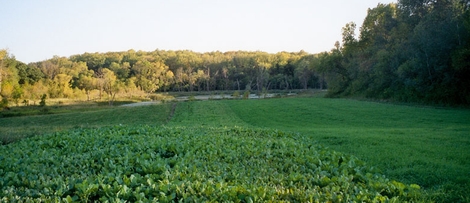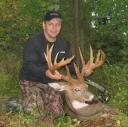
Reasons of establish food plots usually involve supplementation of white-tailed deer during times when forage quantity and/or nutritive value is low. Cost-efficient and biologically effective supplementation can only be accomplished by understanding the seasonal nutritive requirements of white-tailed deer. A wildlife food plot could also be used as an attractant to enhance opportunities for survey, harvest, photography, or simple observation.
Forage Adaptation — By considering the following five topics, one can determine if certain forages are adapted to the area of interest and are able to produce enough actual food to be considered economically feasible. This important initial determination will save you time, money, and frustration.
1. Soil Type — Site selection is critical to successful food plot establishment and production. Determine beforehand if there is an acceptable food plot site capable of supporting good plant growth. Consider carefully the soil type at the site and whether or not the site is subject to drought, flood, or erosion. In addition, make sure to obtain a soil test.
2. Moisture Availability — There is a distinct moisture gradient that transects from the east coast to the west coast. Check long-term precipitation records and periods of drought to increase the success of potential food plot establishment. The importance of timely planting and good seedbed preparation are the best insurance against “crop” failure due to lack of moisture.
3. Temperature Extremes — Many forage plants are sensitive to cold weather. Plants that persist for years at southern climates may not survive the first freeze event in northern areas. On the other hand, some plants are intolerant of the extreme heat that can be experienced in the south. Ensure that forage plants chosen will persist in the region of interest.
4. Forage Palatability — It won’t really matter if you plant a well-adapted forage that produces great quantities of food if deer will not consume it. White-tailed deer are very selective with regards to what they eat. Make sure that the forage is preferred, rather than tolerated or ignored, by deer in your area.
5. Forage Availability — White-tailed deer generally need supplemental nutrition during the late summer and late winter when native forages may be lacking in both quantity or nutritive value. Consider the growth cycle of forage plants chosen for your food plot carefully. Spring-planted, warm season forages generally provide the best supplemental nutrition from June through September. Fall-planted, cool season forage usually provide much-needed food resources from November through April. If the food plot does not offer nutrition when it is needed, during stress periods for wildlife, there really is no point to establishment and maintenance of those species.



I have about an acre that became open do to the harvest of some timber. I would like to plant a food plot for deer but not sure what type of seed to plant. I would like to plant some turnips later in the spring. Looking for some ideas.
John, I would like to chime in here. I might be able to assist you in a few ideas. First off, we need to know what region your in, and roughly what part. This is very important due to the soil types and amount of rainfall. The pH of the soil is very important in the quest for a quality source of food.
Also what are your main objectives? As in short term or long term…also what are you feeding? I have been working with the seed industry everyday for 7 years now and I look forward to hearing back on this.
I have about 8 acres of open field with native grasses surrounded by several hundred acres of hardwoods and cutover pines. I would like to establish a food plot here. The land is in Virginia. I am most interested in a fall plot, but also am interested in a spring plot too.
I’ve been planting food plots for 5 years now Pike County, Illinois, and it seems that I cant grow corn, and my turnips antler king honey hole seems not to get bulbs. I use some lime and fertilizer but cant figure it out. I also want to know what is the best to grow antler development and the best deer attractant? Any suggestions are appreciated.
Ryan B – I’m sure people have told you to test your soil so I hate to even mention it. How much shade is your food plot getting since it’s not growing corn and turnip bulbs? Mineral for antler growth has offered next to “parts per million” conversations as far as evidence of growth.
Best deer attractant depends on your surroundings. If you have 100’s of miles of corn, turnips, water, etc., the best deer attract would be a human taking a dump. It’s all relative to your surroundings.
Fred, you’ve got a point there, but so does each end of a rat turd. Had to use that one-liner given your dump reference. But yes, anything out of the ordinary is likely to draw a response from deer in an area. Find out what is in limited supply and provide that on your land.